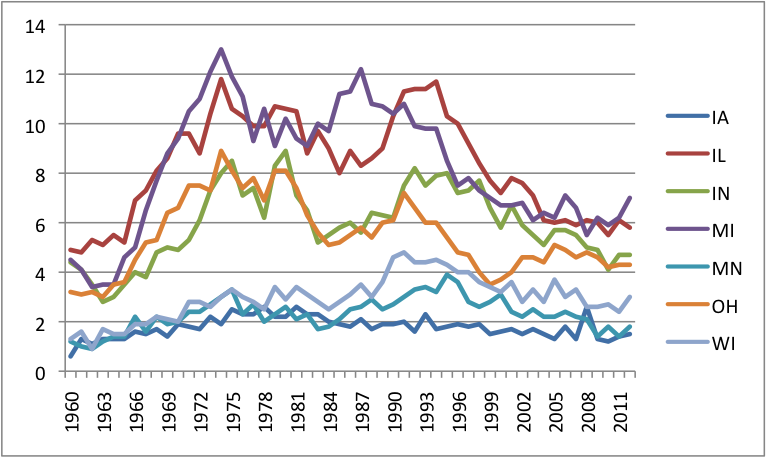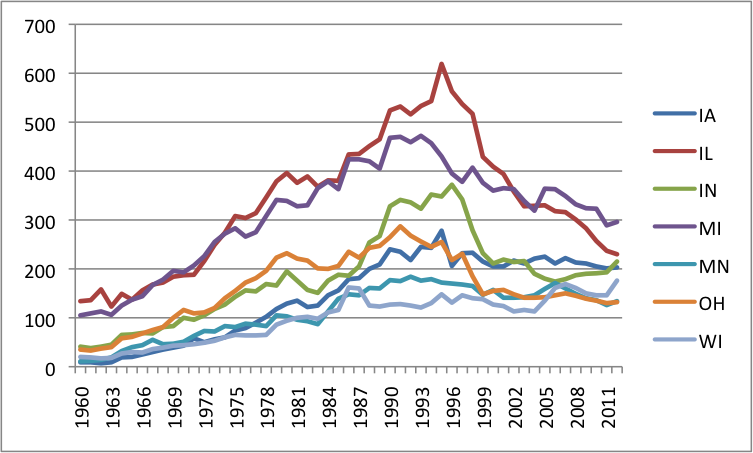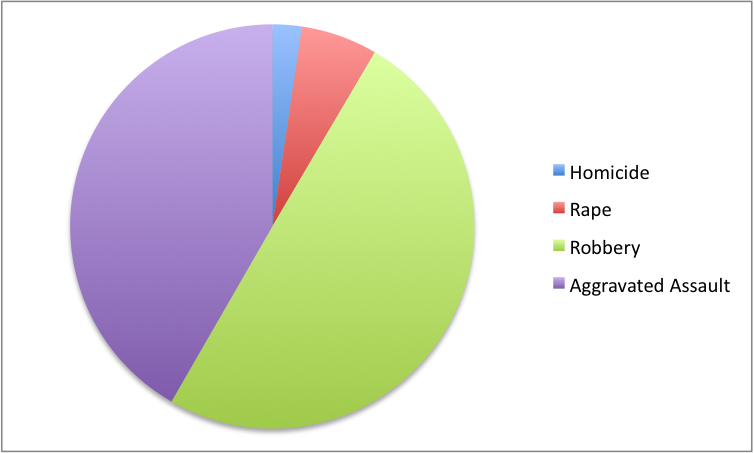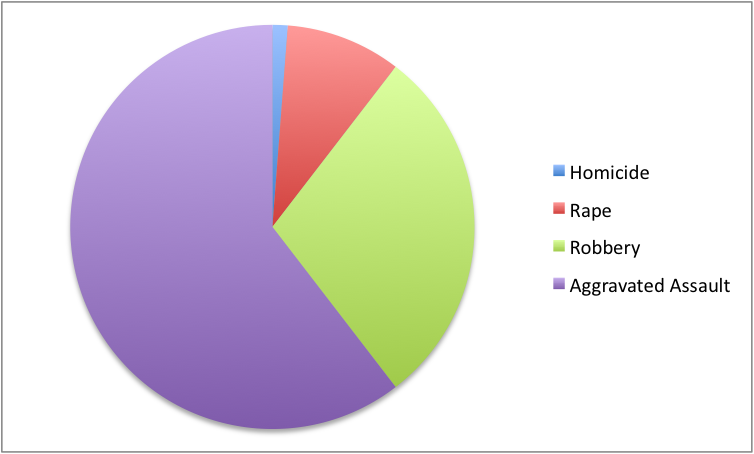In the first post in this series, I described overall violent crime trends in the seven Midwestern states since 1960. In all of the states except for Wisconsin, the basic story was identical: a dramatic spike in violent crime between the mid-1960s and the mid-1990s was followed by a subsequent drop in violence that was nearly as sharp as the increases had been. Wisconsin had the spike, but not the sustained drop of the other states.
In this post, I disaggregate the four categories of crime that go into the overall violence number. Doing so changes the story a bit, as we can see that aggravated assault was by far the biggest driver of the violence spike, and since then has remained stubbornly high. From the standpoint of homicide and robbery, the contemporary Midwest looks only a little more dangerous than the Midwest of 1960; it is only when we add to the picture aggravated assault (and, to a lesser extent, rape) that the data look much worse. There are interesting and uncertain questions about the extent to which these a/a numbers reflect genuine changes in criminal behavior, as to opposed to changes in crime-reporting.
Before considering those questions, let’s look at the numbers. First, consider the seven-state trends for homicide rate (that is, homicides per 100,000 residents):
If you compare these data to the overall data for violent crime from my previous post, you may note that the curves are flatter—the spike between the mid-1960s and mid-1990s is less spiky. For instance, in Wisconsin, overall violence increased by 725%, but homicide only increased by 159%. There are similar gaps in all of the states. Whatever it was that led to the overall spike did not have anywhere near the same impact on the homicide numbers. Moreover, the post-1993 drop had a bigger impact on homicide than on violence overall. Again, consider Wisconsin: our homicides dropped by a third between 1993 and 2012, even as overall violence increased by six percent—a puzzling disparity.
Now, consider the trends for aggravated assault:
Here, we see much sharper spikes before 1993, followed by much more modest reductions since. Indeed, Wisconsin’s aggravated assault rate continued to climb after 1993 and remains 45% higher now than it was in the mid-1990s. It is aggravated assault that accounts entirely for Wisconsin’s stubbornly high rate of violent crime; take aggravated assault out of the picture, and Wisconsin would have experienced a crime drop on the same order of magnitude as some of its neighbors.
The following pie charts make vividly clear the extent to which aggravated assault has been the driver of increases in violent crime rates. The first depicts the relative magnitude of each of the four violent crime categories in 1960 (based on the seven-state average rate), while the second provides the same breakdown for 2012.
1960
2012
A large increase in the a/a share is obvious, accompanied by a correspondingly large decrease in the robbery share. Rape has grown by about the same proportion as a/a, but from a much smaller baseline, which means that it is still contributing much less to the overall violence picture.
Leading the way with the biggest net increases in aggravated assault rate since 1960 are Iowa (2156% increase), Minnesota (1118%), and Wisconsin (7800%). Interestingly, these are the three states that had the lowest a/a rate in 1960—recalling my observation in the earlier post that the historically lowest-violence states seem to be catching up with historically highest-violence states (Illinois and Michigan).
What has caused such extraordinary increases in aggravated assault? One possibility is simply that our society (particularly, it would seem, in the three states anchoring the northwest corner of the Midwest) has grown more violent since 1960. Perhaps this is related to regional economic dislocations and/or demographic changes. Perhaps it is a function of swelling violence in popular culture or the breakdown of the family. No doubt, other possibilities could also be hypothesized. One challenge for any such a “we’ve gotten more violent” account is why homicide has not risen in tandem with aggravated assault. To some extent, this may reflect advances in emergency medicine, which have helped to save many a/a cases from ripening into homicide cases. Another challenge is why the a/a increases have been so uneven across the Midwest. This seems a particular difficulty with pinning the a/a increases on popular culture; it is not clear why violent video games, movies, and rap lyrics would have so much more dramatic an impact on Iowa than on neighboring Illinois, which experienced a relatively modest a/a increase of only 71% between 1960 and 2012.
Another, somewhat different, sort of account would focus on the prevalence of guns. Maybe assaults are no more common today, but perhaps they are more likely to involve guns, which would elevate the crime from simple assault to aggravated. However, it appears that gun ownership in the U.S. has been in decline for decades. It is possible, though, that the kinds of guns most likely to be used in a fight are in wider circulation now, or that the kinds of people who are most prone to violence are now more likely to carry guns with them when they go out, or to draw their firearms when threatened.
It is also possible that the a/a increases do not reflect changes in primary behavior so much as they reflect changes in crime-reporting. Indeed, this may provide the best explanation for why the homicide data look so different from the a/a data. While the homicide numbers are regarded as fairly reliable, the a/a numbers are comparatively mushy. There are at least two areas of potential difficulty: (1) an assault may go unreported to the police, in which case it would never appear in the official data; or (2) an assault may be ignored or improperly classified by the police.
There is, in fact, a longstanding conspiracy theory about police reporting of the a/a numbers in the 1960s and 1970s. Federal grant programs then provided financial incentives for cities to have more crime—the worse your crime problem, the more money you got—which, according to the conspiracy theory, led police departments to inflate their numbers. Since the line between simple assault (which did not “count”) and aggravated assault (which did) was so murky, the easiest way to pad the numbers was to start putting crimes previously classified as simple assaults into the aggravated category.
I don’t know if this padding occurred back in the heyday of the federal Law Enforcement Assistance Administration grants, but I am skeptical it has played much of a role in recent years. At least since the time of the Giuliani era in New York, politicians and police chiefs have understood that careers can rise and fall based on the crime numbers, and I would think that the pressures to depress a/a have accordingly been much more powerful than any pressures pushing in the other direction. This is why the local story about the misclassification of aggravated assaults as simple assaults by the Milwaukee Police Department resonated with so many people in 2012; the story seemed to fit a bigger narrative about police departments “cooking the books” for political gain. (I don’t think, by the way, that anything nefarious was happening in Milwaukee, but the traction the story got seems telling.)
A more important factor than misclassification, I suspect, has been changing social values that have caused many assaults that were previously invisible to become visible. Simply put, large swaths of male violence that were once tolerated or ignored have come to be regarded as socially unacceptable. Domestic violence may furnish the clearest example. How many domestic aggravated assaults in 1960 went unreported to the police, or were handled by the police as disorderly conduct or some other relatively minor offense? As we see the a/a numbers swell in the ensuing decades, that likely reflects to some extent the emerging social (and hence police) preference to treat aggravated assaults in the home as “real” aggravated assaults. (Similar dynamics relating to changed gender roles may also help to explain why the number of reported rapes has grown about as dramatically since 1960 as the number of aggravated assaults.)
The story of changing social attitudes toward domestic violence is a familiar one, but I think there is an even broader story that could be told about growing intolerance of violence more generally. I am always led to think about this over the holiday season during my annual viewing of A Christmas Story, in which Ralphie’s scrap with the schoolyard bully is quickly dismissed with a “boys will be boys” sort of response. This seems to stand in marked contrast to the zero-tolerance policies that are so prevalent in schools today. Of course, we can’t make much of a single movie, but I think much additional evidence could be wheeled out tending to show that male-on-male violence (although perhaps not armed male-on-male violence) was normalized in earlier generations in ways that are not true today. I wonder, in the macho culture of an earlier era, how many barroom fights, gang rumbles, confrontations with bullies, and the like went unreported to the authorities, or were downplayed by the police? It’s impossible to say, of course, but it seems at least plausible that changing attitudes toward male-on-male violence have played a role, in combination with other factors, in the increase in aggravated assault numbers.
This post has already gone on too long, but I should at least briefly note that changes in the a/a numbers may also reflect changes in the relationship between police departments and racial and ethnic minority communities. Police neglect of, and distrust of police in, minority communities in earlier time periods may have depressed the number of assaults reported to the police in those communities. As the barriers of neglect and distrust have diminished, we might expect some increase in the a/a numbers even in the absence of changes in actual criminal activity.




